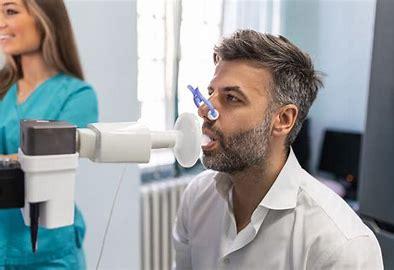Introduction
Pulmonary Function Testing (PFT) is a critical diagnostic tool used to assess how well your lungs are working. These non-invasive tests measure lung volume, capacity, rates of flow, and gas exchange, helping healthcare providers diagnose and monitor respiratory conditions such as asthma, chronic obstructive pulmonary disease (COPD), and pulmonary fibrosis.
In this comprehensive guide, we’ll explore:
-
What Pulmonary Function Testing is
-
Different types of PFTs
-
Who should get tested
-
How to prepare for a PFT
-
What the results mean
-
The benefits and limitations of PFTs
By the end, you’ll have a clear understanding of why these tests are essential for maintaining lung health.
What Is Pulmonary Function Testing?
Pulmonary Function Testing refers to a group of tests that evaluate how effectively your lungs take in and release air, as well as how well they transfer oxygen into your bloodstream. These tests help doctors:
-
Diagnose lung diseases
-
Monitor disease progression
-
Assess treatment effectiveness
-
Evaluate lung function before surgery
According to the American Thoracic Society (ATS), PFTs are among the most reliable methods for detecting obstructive and restrictive lung disorders.
Types of Pulmonary Function Tests
There are several types of PFTs, each measuring different aspects of lung function:
1. Spirometry
Purpose: Measures how much and how quickly you can exhale air.
Key Metrics:
-
Forced Vital Capacity (FVC) – Total amount of air exhaled forcefully.
-
Forced Expiratory Volume in 1 Second (FEV1) – Amount of air exhaled in the first second.
-
FEV1/FVC Ratio – Helps differentiate between obstructive and restrictive diseases.
Who Needs It? Patients with suspected asthma, COPD, or bronchitis.
2. Lung Volume Testing
Purpose: Measures total lung capacity (TLC) and residual volume (RV).
Methods:
-
Body Plethysmography – Uses a sealed chamber to measure lung volumes.
-
Nitrogen Washout or Helium Dilution – Estimates lung capacity via gas exchange.
Who Needs It? Patients with restrictive lung diseases like pulmonary fibrosis.
3. Diffusion Capacity Test (DLCO)
Purpose: Evaluates how well oxygen passes from the lungs into the bloodstream.
Who Needs It? Patients with emphysema, pulmonary hypertension, or interstitial lung disease.
4. Bronchial Provocation Test
Purpose: Assesses airway responsiveness in suspected asthma cases.
Procedure: Inhaling methacholine or histamine to trigger mild bronchoconstriction.
5. Exercise Stress Test
Purpose: Measures lung function during physical activity.
Who Needs It? Patients with unexplained shortness of breath during exertion.
Who Should Undergo Pulmonary Function Testing?
PFTs are recommended for individuals experiencing:
-
Chronic cough or wheezing
-
Shortness of breath (dyspnea)
-
History of smoking
-
Exposure to lung-damaging pollutants (asbestos, coal dust)
-
Pre-surgical evaluation (especially before major surgeries)
The Centers for Disease Control and Prevention (CDC) reports that over 16 million Americans have COPD, many of whom benefit from regular PFTs for disease management.
How to Prepare for a Pulmonary Function Test
To ensure accurate results:
✔ Avoid smoking for at least 24 hours before the test.
✔ Skip heavy meals and caffeine 4-6 hours prior.
✔ Wear loose clothing to allow unrestricted breathing.
✔ Follow your doctor’s instructions regarding inhaler use.
What to Expect During the Test
-
Spirometry: You’ll take a deep breath and exhale forcefully into a mouthpiece.
-
Lung Volume Test: You’ll sit in a clear booth and breathe normally while pressure changes are measured.
-
Diffusion Capacity Test: You’ll inhale a harmless gas and hold your breath briefly.
The entire process usually takes 30-90 minutes, depending on the tests performed.
Interpreting PFT Results
Results are compared to normal values based on age, sex, height, and ethnicity. Abnormal findings may indicate:
| Condition | Key PFT Findings |
|---|---|
| Asthma | ↓ FEV1/FVC, reversible with bronchodilators |
| COPD | ↓ FEV1/FVC, irreversible obstruction |
| Pulmonary Fibrosis | ↓ TLC, ↓ FVC (restrictive pattern) |
| Emphysema | ↓ DLCO, hyperinflated lungs |
Your doctor will explain your results and recommend further testing or treatment if needed.
Benefits of Pulmonary Function Testing
✅ Early Detection: Identifies lung diseases before symptoms worsen.
✅ Personalized Treatment: Helps tailor medications like bronchodilators or steroids.
✅ Surgical Risk Assessment: Determines if lungs can handle anesthesia.
✅ Monitoring Progress: Tracks disease progression or improvement.
Limitations of PFTs
❌ Effort-Dependent: Requires patient cooperation for accurate results.
❌ Not Diagnostic Alone: Often paired with imaging (X-rays, CT scans).
❌ False Positives/Negatives: Conditions like obesity can skew results.
Frequently Asked Questions (FAQs)
1. Is Pulmonary Function Testing painful?
No, PFTs are non-invasive and painless, though some may feel lightheaded from forceful breathing.
2. How often should PFTs be done?
Patients with chronic lung conditions may need annual testing, while others only when symptoms arise.
3. Can children undergo PFTs?
Yes, specialized pediatric PFTs are available for kids as young as 5 years old.
4. Are there risks involved?
PFTs are very safe, but those with severe heart conditions should consult their doctor first.
Conclusion
Pulmonary Function Testing is a vital tool in diagnosing and managing respiratory diseases. Whether you’re experiencing breathing difficulties or need pre-surgical evaluation, PFTs provide invaluable insights into lung health. Early detection through these tests can lead to better treatment outcomes and improved quality of life.



